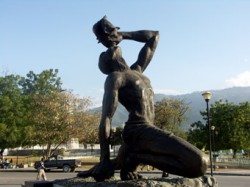 Most Haitians can re-tell the triumphant account of the Haitian Revolution (1791-1803) by heart. After all, it is no small feat that an uprising of slaves in Santo Domingo, the richest colony of that era, overthrew Napoleon Bonaparte’s army. As we celebrate Haiti’s 208th anniversary and the start of the 2012 New Year, I thought it only fair to set the record straight on why we are so proud of this history.
Most Haitians can re-tell the triumphant account of the Haitian Revolution (1791-1803) by heart. After all, it is no small feat that an uprising of slaves in Santo Domingo, the richest colony of that era, overthrew Napoleon Bonaparte’s army. As we celebrate Haiti’s 208th anniversary and the start of the 2012 New Year, I thought it only fair to set the record straight on why we are so proud of this history.
- Haiti’s victorious revolution, led by General Touissant L’Overture, made it the 1st Black republic in the world.
- Jean Jacques Dessalines continued to lead the rebellion after L’Overture’s capture in 1802.
- The 1803 Louisiana Purchase, notable for doubling the size of the U.S. for only 4 cents an acre, resulted from France’s desperation during the war.
- The French were defeated in the Battle of Vertieres on November 18th, 1803 and Dessalines proclaimed Haitian Independence on January 1st, 1804.
- Dessalines named the country “Haiti” after the Taino word Ayiti – which means, “Land of many mountains.”
- After Dessalines’ assassination in 1806, founding father Henri Christophe declared himself king of northern Haiti and ruled as such until intense opposition led to his suicide in 1820.
- Christophe determined to prove the strength of black people and Haiti’s ability to fight future attacks. Thus, his Citadelle Laferriere is the largest fortress in the Western Hemisphere and is designated as a UNESCO World Heritage Site.
- The remains of Christophe’s San Souci Palace is also a World Heritage Site.
Just so you know, the fight was not over after independence.
- France charged Haiti $20 billion U.S. dollars (today) as reparations for independence. This debt was not paid off until 1922; and
- The U.S. did not acknowledge Haiti until 1862 when Frederick Douglass went to establish diplomatic relations.
So there you have it, folks! (Well some of it at least). Yes – Haiti’s struggles remain plentiful and this year has challenges that need tackling. Nonetheless, let these historical facts serve as an opportunity for us to take a small step forward in restoring Haiti’s dominance.
——————
Photo credit – “Neg Mawon means at once — the marooned man, the runaway slave and the free man — testament of the complex history of the Haitian people stolen from Africa, marooned on an island and liberated though a brave and radical revolution. Shackles broken, machete in hand, the free man blows a conch to gather others in his fight for the freedom and dignity of all people and for the self-evident truth–that all men are created equal.”
Post January 12th, 2010 earthquake, Neg Mawon still stands outside of the crumbled Haitian National Palace.


About The Author: Vanessa L.
More posts by Vanessa L.